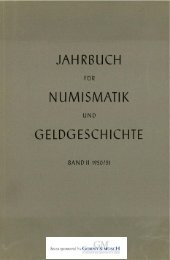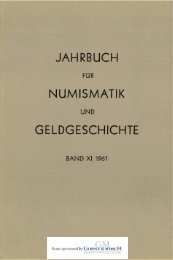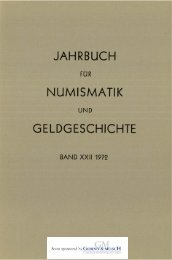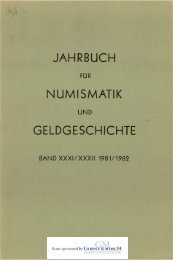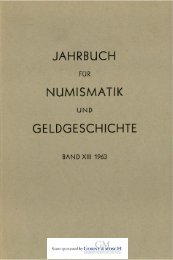24 David MacDonaldLeague and, with rare exception, for the coinages of the individual Boiotiancities until the time of Alexander. The wheel on the reverse is a distinctivecoin type of Chalkis, related to the local cult of Apollo. The appearance ofthese two badges on a single coin indicates a political combination, such asclearly existed about 506 B.C. when the Boiotian League and Chalkis ravagednorthern Attika at the time of the abortive Spartan campaign led byCleomenes against Athens.3E. Babelon proposed substantially this thesis shortly after the turn of thecentury. The important Taranto Hoard of archaic Greek silver coins containedone of the two known specimes of the issue,4 and Babelon dated thedeposition of the entire hoard to c. 509 B.C. on the basis of the "Boiotian/Chalkis"coin, believing it to be the latest coin in the hoard. Subsequentstudy of other issues represented in the hoard has lowered the depositiondate of the hoard to 490-480 B.C., providing a terminus ante quem of sortsfor the issue, although one so late as to be of little value.5Babelon's thesis has been repeated broadly, with some modifications.There is now little insistence on c. 506 B.C. as the date for the issue; theremay well have been a number of other alliances between Chalkis and Boiotiansin the late sixth century that are not mentioned in our sources.6 Thestyle and fabric of the issue, in the light of modern numismatic opinion, suggesta date substantially earlier, about 520 B.C.7 Some scholars have seen theissue as evidence of a "foedus aequum", but Wallace claims it as proof thatChalkis actually joined the Boiotian League for some time during the latesixth century.8 Numismatists in recent years have generally recognized that3 Her. 5, 74-77. The event is variously dated between 509 and 505 B.C. by modern historians.An able and balanced treatment: R.J. Buck, A History of Boeotia, Alberta 1979, 114-117.4 n. 1 supra.5 S.P. Noe, The Coinage of Metapontum Parts 1 and 2, with additions and corrections by AnnJohnston, New York 1984, 37-40.6 Suggested as a possibility in Kraay, Archaic, 109.Kraay, Archaic, 109, and C.T. Seltman, Greek Coins, 2nd ed. London 1955, 57 note thesimilarity of fabric to the Athenian Wappenmünzen and early owl tetradrachms, which arecurrently generally dated c. 520 B.C. The chronology of early Greek coinages is a vexed Problem.Contrast M. Vickers ultra-low chronology, Early Greek Coinage, a Reassessment,NumChr 1985, 1-44, with the centrist Position of J.H. Kroll and N.M. Waggoner, Datingthe Earliest Coins of Athens, Corinth and Aegina, AJA 1984, 325-340. Vickers' datingwould force the dates of other series to be lowered as well, crowding issues unacceptablyin the early fifth century. Vickers seems also to have dismissed too quickly much hoardevidence. He does demonstrate, however, the uncertainties of other dating schemes. All thismakes it possible that the shield/wheel issue could have appeared c. 506 B.C., but here isno specific reason to date it so.8 Wallace, Early, p. 38 n. 2: "Coins commemorating alliances are not well authenticated, andI should prefer to suppose that Chalkis temporarily joined the Boiotian League in, or soonbefore, 506 — as she did again briefly 200 years later (see M. Holleaux„Note sur un decretd'Eretrie, in REG 1897, 157-89, reprinted in Etudes d'epigraphie et d'histoire grecques I(Paris, 1938), 41-73, especially p. 60."
Significance of „Boiotian League/Chalkis" Silver Issue 25the entire thesis is based on slender grounds,9 yet few historians seem awareof how slender are those grounds. The issue can be explained moreeconomically as a manifestation of certain eclectic trends apparent in Greekcoinage of the sixth century as a whole.The obverse type of the issue is a shield of the type commonly called"Boiotian." The designation is modern and derives from its frequent use asa type on Boiotian coins. The shield should more properly be called an"heroic" shield. Apparently a descendant of the figure-eight shield of theBronze Age and the Dipylon shield of the Dark Ages, the heroic shield mayhave existed only as an artistic convention. In art it is commonly carried bydeities and heroes.10 The only thing specifically "Boiotian" about this typeof shield is its use as the obverse type on the coinage of Boiotia. That Boiotiancoinage probably did not, however, begin until some considerable time,one or perhaps two decades, after the shield/wheel issue."Despite its recurrent appearance on Boiotian coinage from the late sixthcentury B.C. until the time of Alexander, the heroic shield was never exclusivelyidentified with Boiotia in the ancient world. It occurs on artifactsfrom many areas of the Greek world and is particularly common on Atticpottery, where even Athena carries it on occasion, although the aegis is hernormal protection in battle.12 Salamis used the same heroic shield as a coin910I I12E.g. the cautious assessments of Martin Price and Nancy Waggoner, Archaic Greek SilverCoinage The Asyut Hoard, London 1975, p. 19, particulary n. 12 (p. 129); Kraay, Archaic,90-91. The following observations about the "Boiotian" shield were largely anticipatedin Imhoof-Blumer, Monnaies grecques, 221-224, the initial publication of the shield/wheelcoin. Imhoof-Blumer clearly considered and rejected the sort of political interpretation laterput forth by Babelon and others, but Imhoof-Blumer's observations have been largely ignored.A.M. Snodgrass, Early Greek Armour and Weapons, Edinburgh 1964, 58-60 represents theprevalent view that the "Boiotian" shield was merely an artistic convention. P. Connolly,Greece and Rome at War, London 1981, 51 suggests the "Boiotian" shield would haveallowed two-handed use of the pike, but presents no proof that this was actually done inthe archaic or classic periods. Snodgrass, Early, 58-60 points out that the artificial characterof the shield is apparent in representations where it is used sideways, with the kidneyshapedopening son the top and bottom and the long axis held horizontally, and providedwith conventional hoplite shield grips, e.g. J. Boardman, Athenian Black Figure Vases, NewYork 1974, fig. 73 (Vatican 309).Kraay, Archaic, 109-110; Price and Waggoner, Asyut, 53. The beginning of Boiotiancoinage cannot be dated closely. General considerations of style and fabric point to a datein the late sixth century. A few reverse punch dies of the earliest series copy reverses ofAigina perhaps a few years earlier than 510 B.C.; most copy Aiginetan reverses later thanthat date (Price and Waggoner, Asyut, 53, 73-75). The second earliest series bears letters,indicative of an early fifth century date. All together seems to indicate Boiotian coinagebegan c. 510 B.C. or even a few years later. Even if the first Boiotian coinages are assumedto have antidated the shield/wheel issue by some few years, time was hardly sufficient toestablish the heroic shield as the symbol of Boiotia.G. Lippold, Griechische Schilde, Münchener archäologische Studien dem Andenken AdolfFurtwänglers gewidmet, Munich 1909, 437.
- Seite 1: JAHRBUCHFÜRNUMISMATIKUNDGELDGESCHI
- Seite 5 und 6: JAHRBUCHFÜRNUMISMATIK UND GELDGESC
- Seite 7 und 8: INHALTVorbemerkung der Redaktion 7G
- Seite 9: 7Vorbemerkung der RedaktionEntgegen
- Seite 12 und 13: 10 Gerd DethlefsDie Zeichnung befin
- Seite 14 und 15: 12 J.Elayi, A.G.Elayiexplicit inscr
- Seite 16: 14 J. Elayi, A.G.Elayione bears on
- Seite 19 und 20: Abbreviations Used by Byblos,Tyre a
- Seite 21 und 22: Abbreviations Used by Byblos,Tyre a
- Seite 23 und 24: Abbreviations Used by Byblos,Tyre a
- Seite 25: Jahrbuch f. Numismatik u. Geldgesch
- Seite 29 und 30: Significance of „Boiotian League/
- Seite 31: Significance of „Boiotian League/
- Seite 34 und 35: 32 Peter F. Dorceycoinage. Accordin
- Seite 36 und 37: 34 Peter F. Dorceyquem of 120.'° A
- Seite 38 und 39: 36 Peter F.DorceyEETI(AI)2° and HP
- Seite 40 und 41: 38 Peter F. DorceyTable I: Catalogu
- Seite 42 und 43: 40 Peter F.DorceyTable II: Coin Hoa
- Seite 44 und 45: 42 Allan A. LundDer Germanenbegriff
- Seite 46 und 47: 44 Allan A. Lundnen sie, wie die Fo
- Seite 48 und 49: 46 Allan A. Lunddie Angaben über d
- Seite 50 und 51: 48 Allan A. Lundw a 200 Kilometer b
- Seite 52 und 53: 50 Allan A. Lundrelle Grenze fielen
- Seite 55 und 56: Jahrbuch f. Numismatik u. Geldgesch
- Seite 57 und 58: Ein weiterer Aureus des Pescennius
- Seite 59 und 60: Jahrbuch f. Numismatik u. Geldgesch
- Seite 61 und 62: 1Bronzeprägung von Laodikeia in Sy
- Seite 63 und 64: Bronzeprägung von Laodikeia in Syr
- Seite 65 und 66: Bronzeprägung von Laodikeia in Syr
- Seite 67 und 68: Bronzeprägung von Laodikeia in Syr
- Seite 69 und 70: Bronzeprägung von Laodikeia in Syr
- Seite 71 und 72: Bronzeprägung von Laodikeia in Syr
- Seite 73 und 74: Bronzeprägung von Laodikeia in Syr
- Seite 75 und 76: Bronzeprägung von Laodikeia in Syr
- Seite 77 und 78:
Bronzeprägung von Laodikeia in Syr
- Seite 79 und 80:
Bronzeprägung von Laodikeia in Syr
- Seite 81 und 82:
Bronzeprägung von Laodikeia in Syr
- Seite 83 und 84:
Bronzeprägung von Laodikeia in Syr
- Seite 85 und 86:
Bronzeprägung von Laodikeia in Syr
- Seite 87 und 88:
Bronzeprägung von Laodikeia in Syr
- Seite 89 und 90:
Bronzeprägung von Laodikeia in Syr
- Seite 91 und 92:
Bronzeprägung von Laodikeia in Syr
- Seite 93 und 94:
Bronzeprägung von Laodikeia in Syr
- Seite 95 und 96:
Jahrbuch f. Numismatik u. Geldgesch
- Seite 97 und 98:
Zwei Bleigewichte in München 95mei
- Seite 99 und 100:
Zwei Bleigewichte in München 97Val
- Seite 101 und 102:
Zwei Bleigewichte in München 99nö
- Seite 103 und 104:
Jahrbuch f. Numismatik u. Geldgesch
- Seite 105 und 106:
Saalfeld als Münzstätte der Leini
- Seite 107 und 108:
Saalfeld als Münzstätte der Leini
- Seite 109 und 110:
Saalfeld als Münzstätte der Leini
- Seite 111 und 112:
Saalfeld als Münzstätte der Leini
- Seite 113 und 114:
Saalfeld als Münzstätte der Leini
- Seite 115 und 116:
Saalfeld als Münzstätte der Leini
- Seite 117 und 118:
Saalfeld als Münzstätte der Leini
- Seite 119 und 120:
Saalfeld als Münzstätte der Leini
- Seite 121 und 122:
Saalfeld als Münzstätte der Leini
- Seite 123 und 124:
Saalfeld als Münzstätte der Leini
- Seite 125 und 126:
Saalfeld als Münzstätte der Leini
- Seite 127 und 128:
Saalfeld als Münzstätte der Leini
- Seite 129 und 130:
Saalfeld als Münzstätte der Leini
- Seite 131 und 132:
129ZUSAMMENFASSUNGEN(erstellt von B
- Seite 133 und 134:
Zusammenfassungen/Conclusions 131Ar
- Seite 135 und 136:
Jahrbuch f. Numismatik u. Geldgesch
- Seite 137 und 138:
Buchbesprechungen, Jb.f.Num.u.Geldg
- Seite 139 und 140:
Buchbesprechungen, Jb.f.Num.u.Geldg
- Seite 141 und 142:
Buchbesprechungen, Jb.f.Num.u.Geldg
- Seite 143:
Buchbesprechungen, Jb.f.Num.u.Geldg
- Seite 146 und 147:
144 Jahresbericht Staat!. Münzsamm
- Seite 149 und 150:
Jahrbuch f.Numismatik u. Geldgeschi
- Seite 151 und 152:
Jahresbericht B.N.G. 149Stadt lasse
- Seite 153:
Jahresbericht B.N.G. 151Band 35, k
- Seite 156 und 157:
154 Jahresbericht B.N.G.der Heimat
- Seite 158 und 159:
156 Jahresbericht B.N.G.Medaillen"
- Seite 161 und 162:
vyaltoti9er canyexitift, _s,9t.czr
- Seite 163 und 164:
Tafel 3123Zu: J. und A.G. Elayi, Sy
- Seite 165:
Tafel 5Zu: Peter F. Dorcey, The Pos
- Seite 169 und 170:
Zu: Eckhard Meyer, Die Bronzeprägu
- Seite 171 und 172:
Elf el 949Zu: Eckhard Meyer, Die Br
- Seite 173 und 174:
Zu: Eckhard Meyer, Die Bronzeprägu
- Seite 175 und 176:
Zu: Eckhard Meyer, Die Bronzeprägu
- Seite 177 und 178:
Zu: Eckhard Meyer, Die Bronzeprägu
- Seite 179 und 180:
Zu: Eckhard Meyer, Die Bronzeprägu
- Seite 181 und 182:
Tafel 19Maßstab:1 : 1Foto: Staatl.
- Seite 183 und 184:
Tafel 211 2 34 5. , )(4. ' cili li





